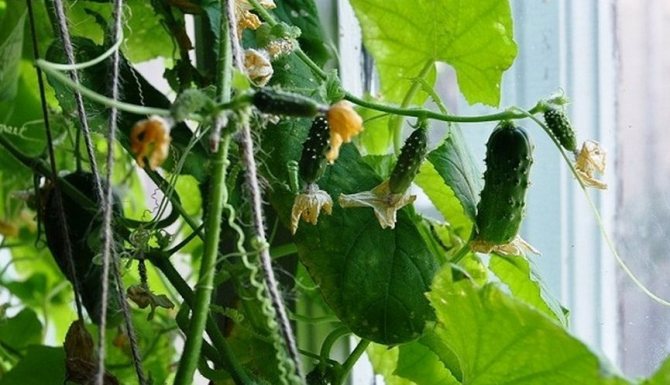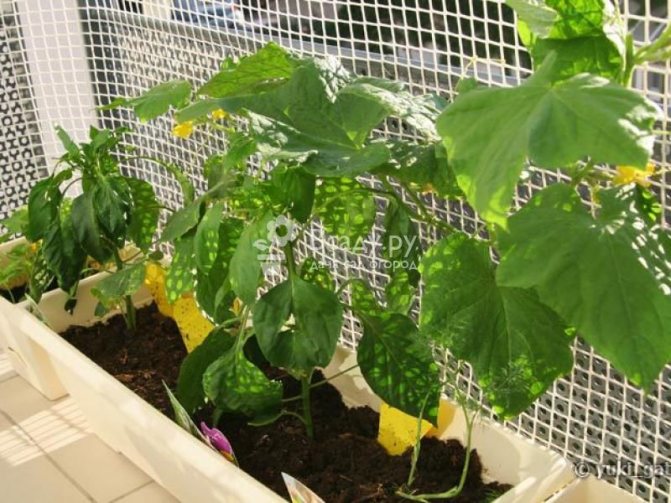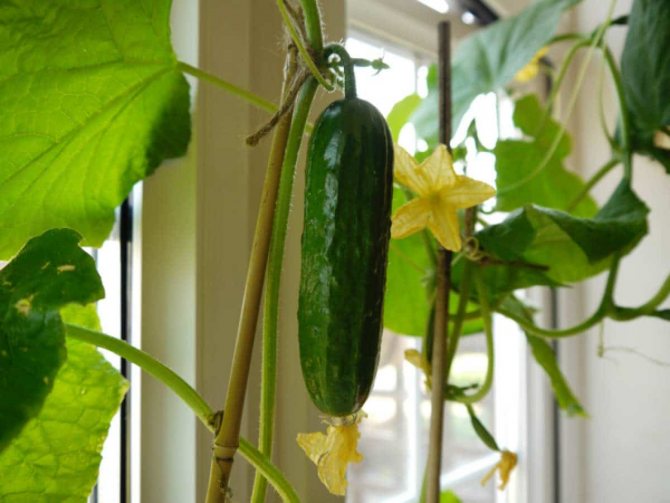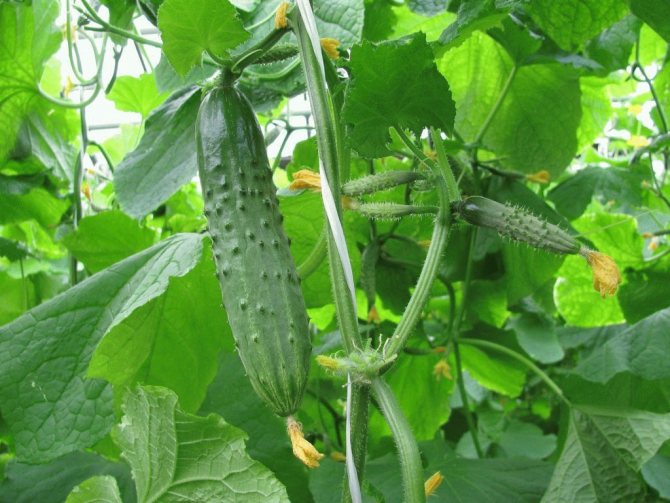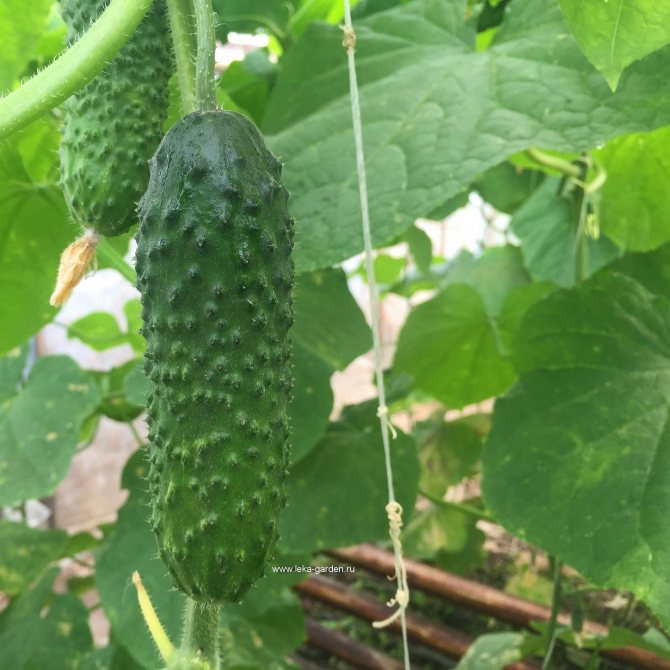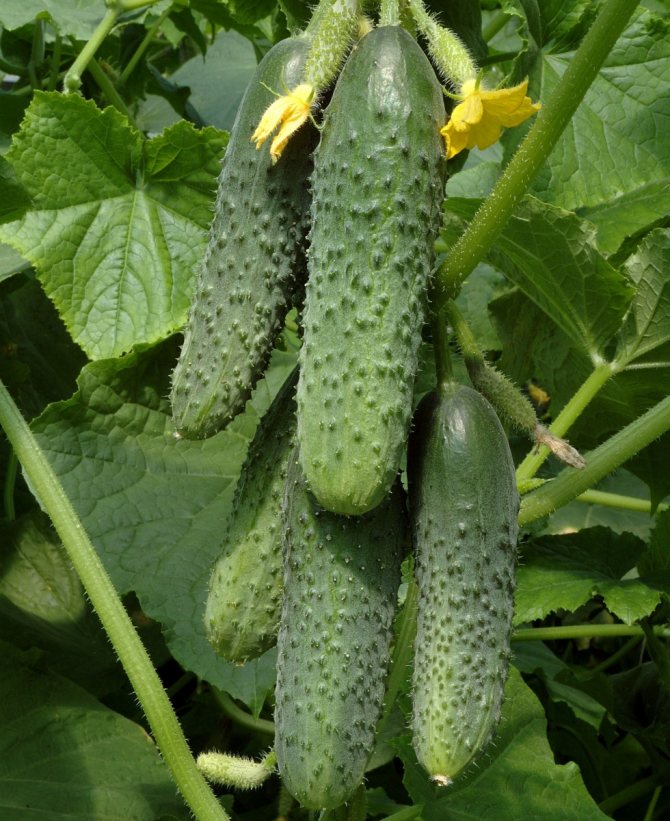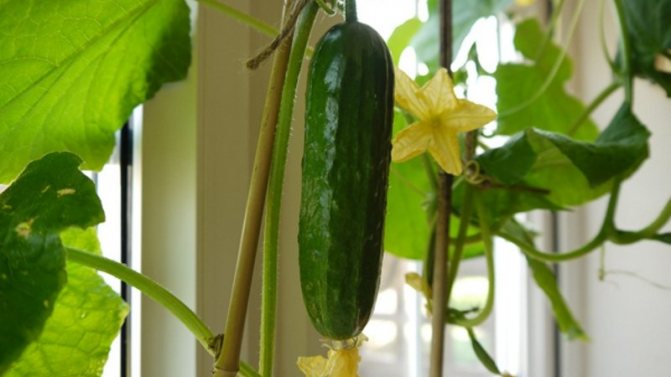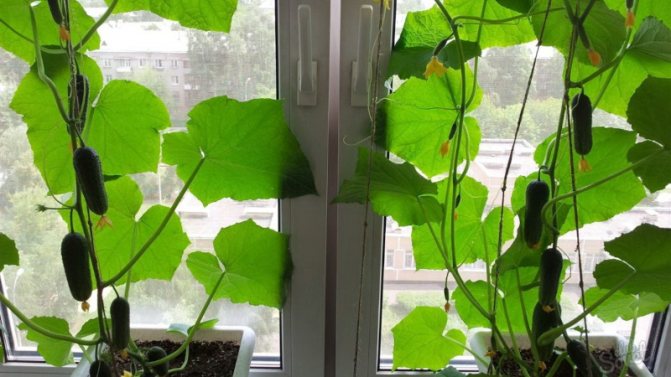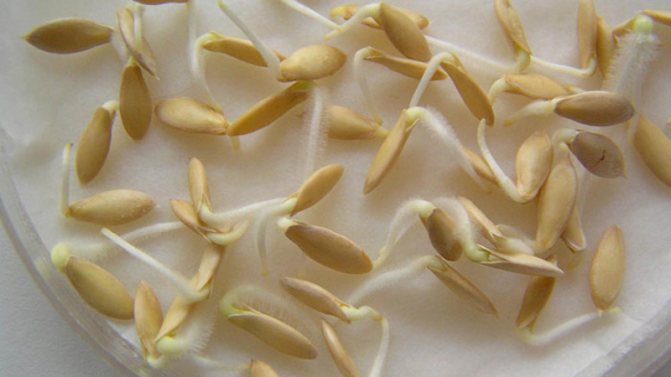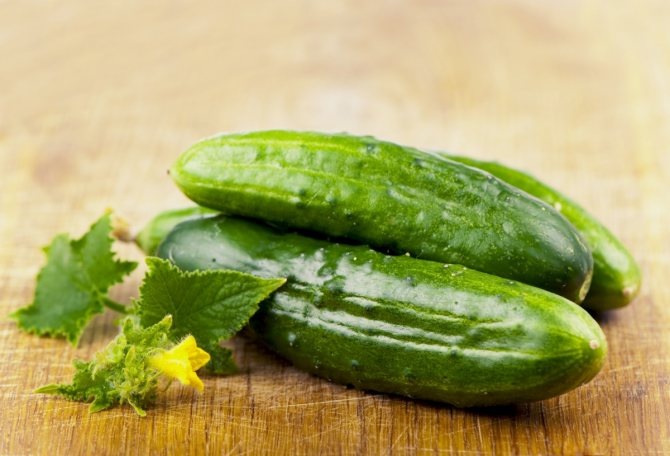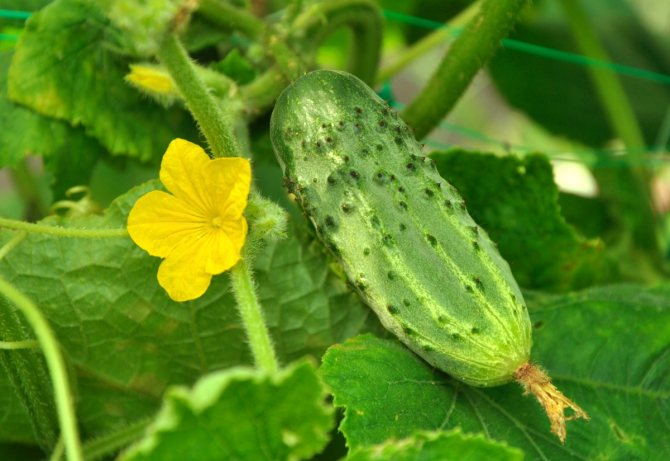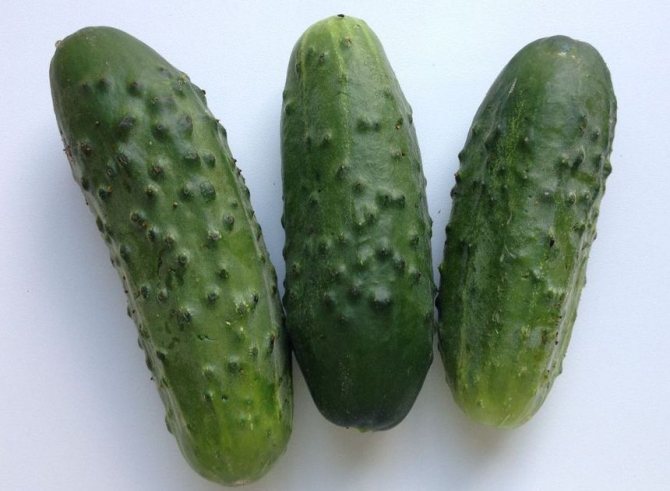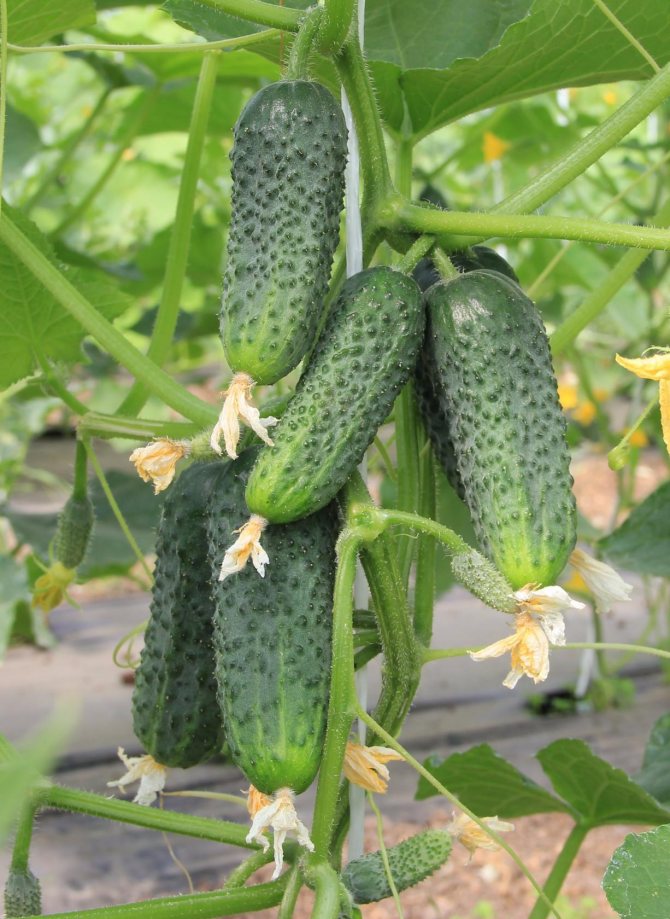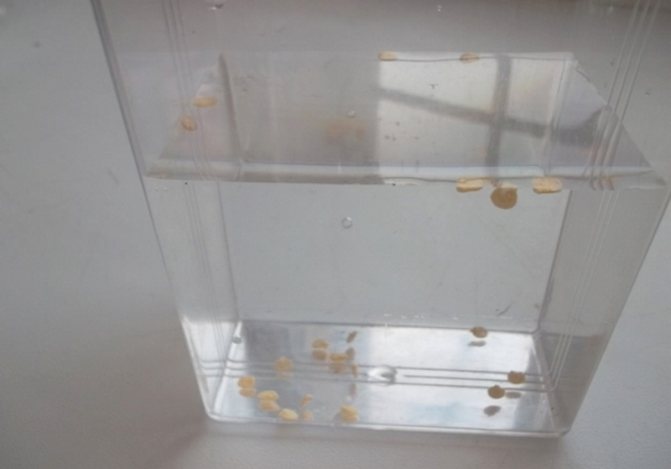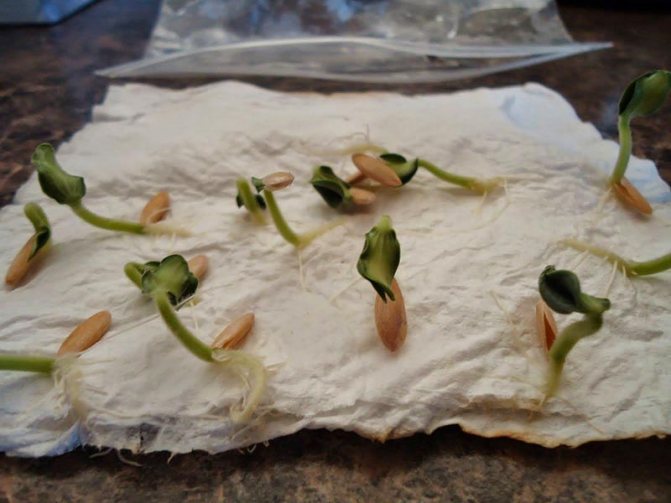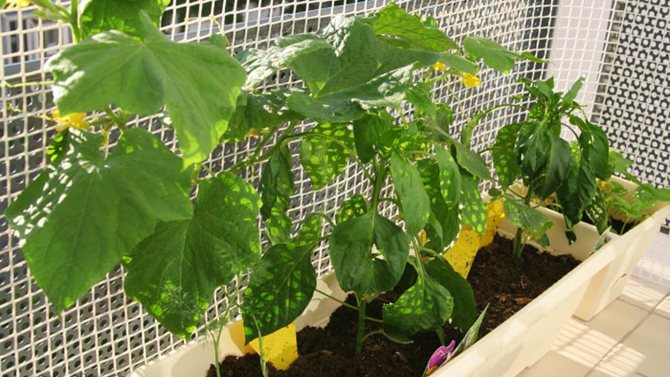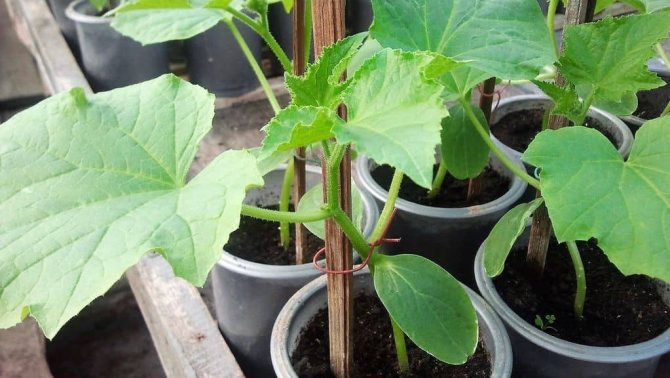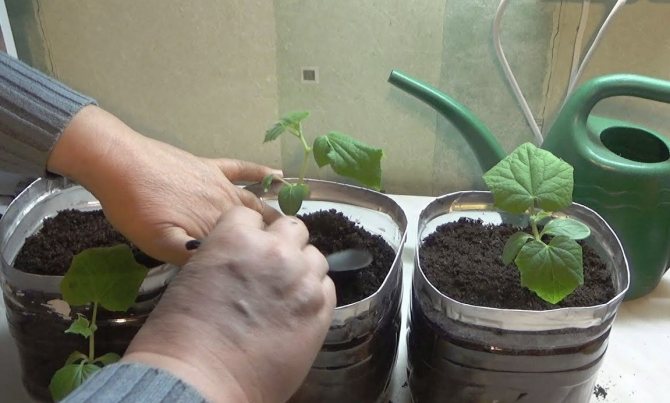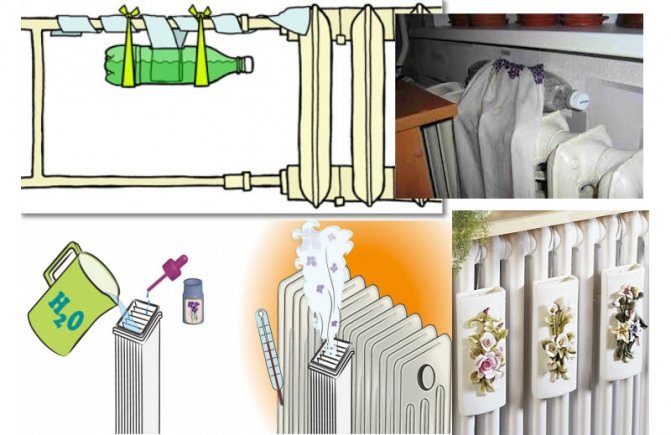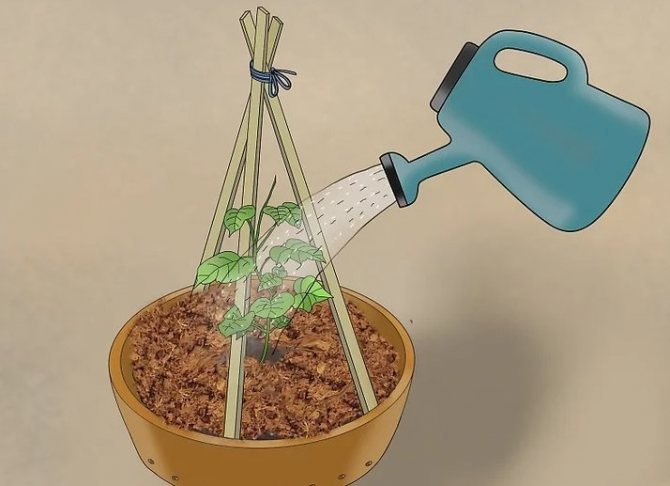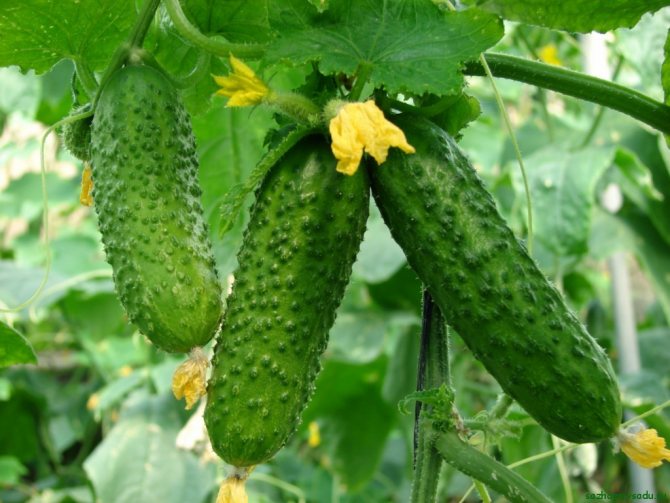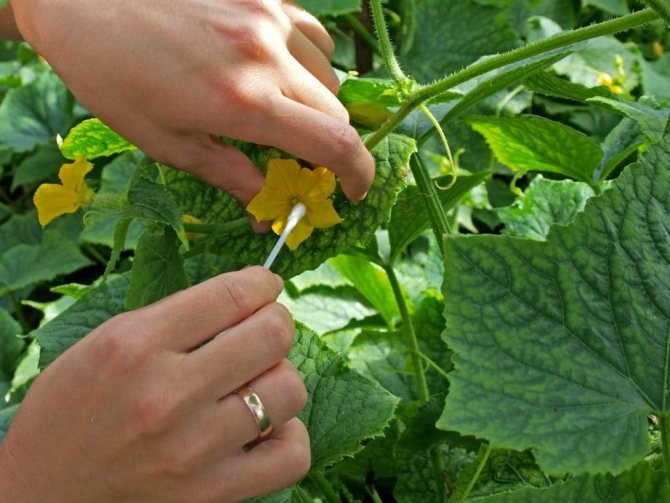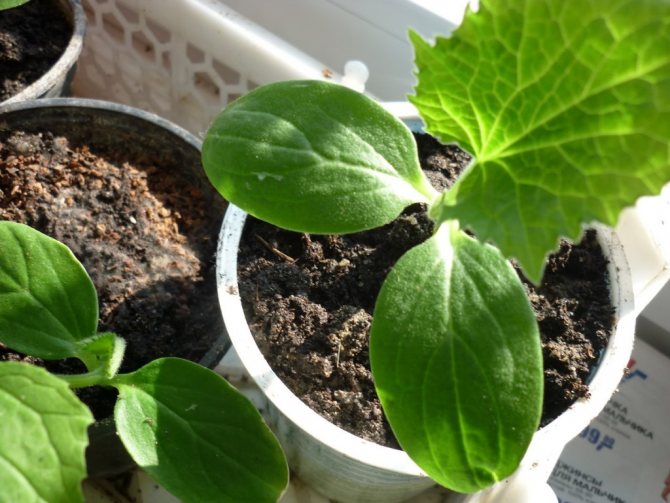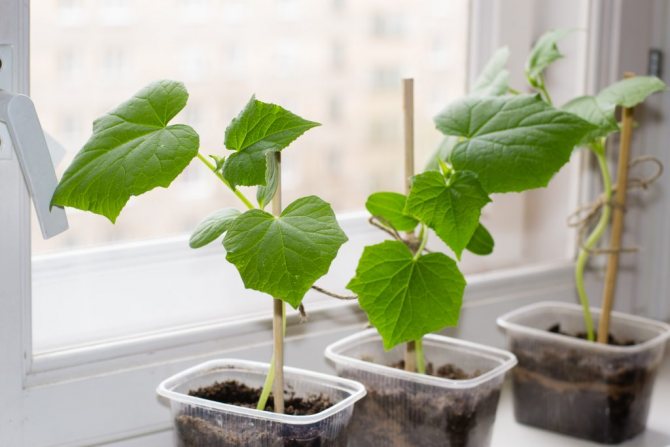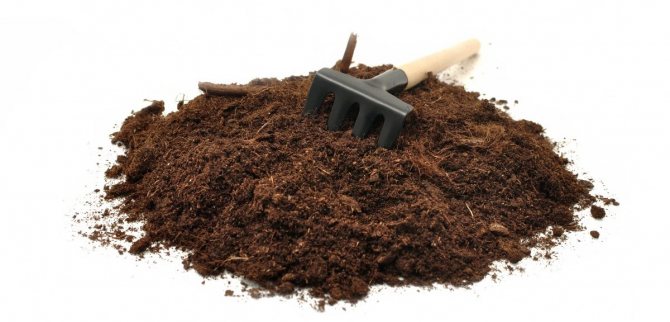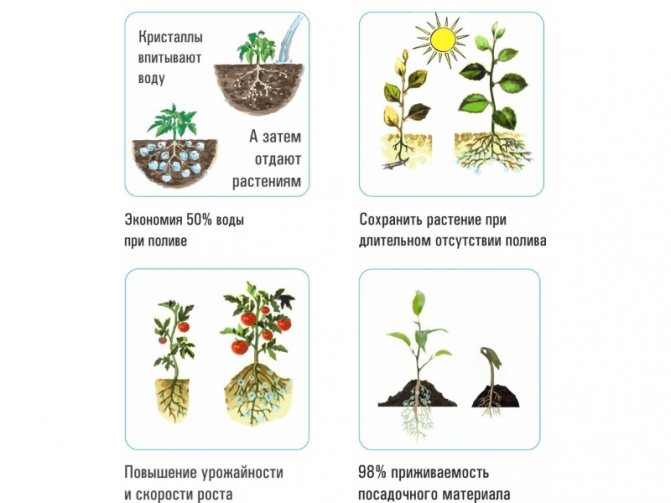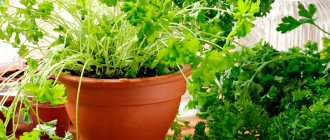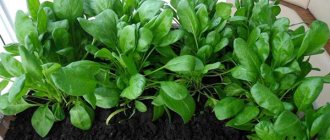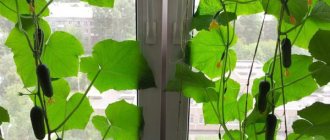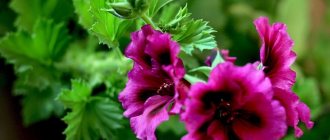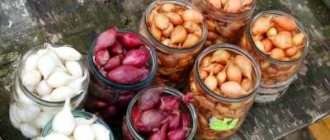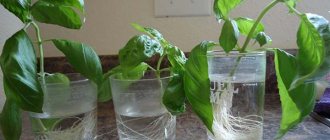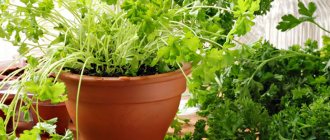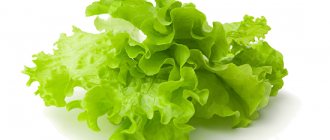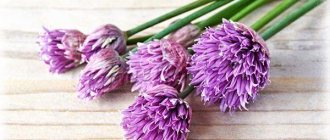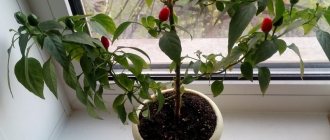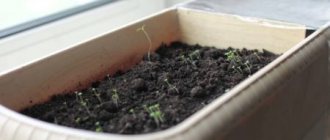Hello to all the guests of my blog! If you are here, then you, like me, are thinking about how to grow cucumbers on the windowsill. Today I will share my experience in these experiments with both mine and other gardeners. By following these tips, you can grow other healthy vegetables right in your apartment.
The first condition for a good harvest of domestic cucumbers is correctly selected seed varieties. We will consider which varieties and hybrids are best suited for growing in an apartment.
The second condition for strong seedlings to appear from the seeds is the soil mixture and the temperature in the room. If necessary, fragile seedlings should be covered with a glass cover to create greenhouse conditions.
And in order for the plants to grow and develop well later, you need to provide them with enough light throughout the day. Therefore, on cloudy days, we will include additional artificial lighting.
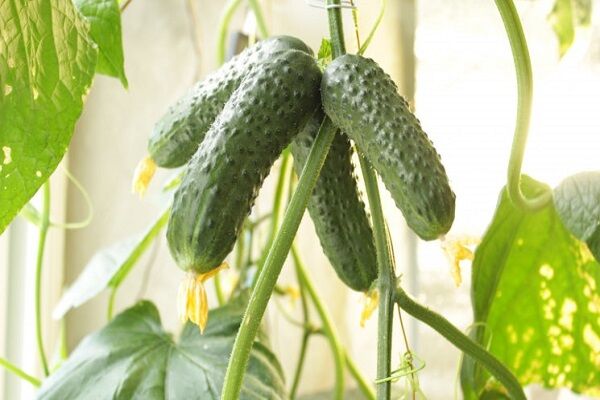
Optimal conditions for growing cucumbers in an apartment
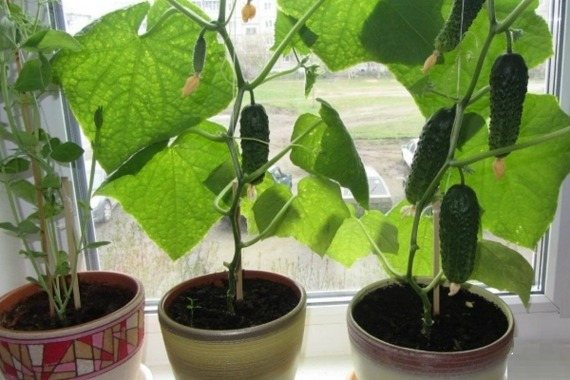

You can grow cucumbers in an apartment on windows with a south, east and southeast orientation, where direct sunlight falls at certain hours.
North and west window sills are not suitable for this purpose. In this case, fruiting will not be possible even with the use of backlighting.
There should be no drafts in the room, consider this point if you are used to regularly opening the windows for ventilation. You can grow cucumbers on a glazed and insulated loggia.
Since the culture loves warmth, the temperature should be maintained at 18 degrees and above during the day and at least 15 degrees at night.
On cloudy days, cucumbers need additional lighting. For this, a fluorescent lamp, LEDs or phytolamp with a special radiation spectrum, favorable for plants, can be used.
On those days when it is cold on the window (due to severe frost outside), preference should be given to halogen lamps, which heat the air near them and will serve as an additional source of heat.
Diseases and pests
When growing cucumbers in the winter on the window, you should not be afraid of insects. From autumn to spring, the larvae do not wake up, they are in the dormant stage. The worst enemy of indoor vegetables is a mushroom mosquito. Their larvae live in the ground, eat any plants, gnawing at their roots. If you notice midges or harmful larvae, water the soil under the cucumbers with Zemlyan, Aktar, Mukhoed.
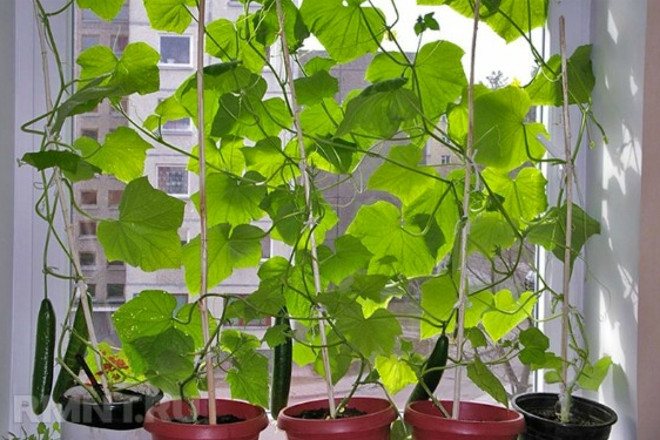

But there are much more diseases in indoor zelents. Black leg, rot provokes improper care, lack of drainage with excessive watering. When the infection is detected, you need to remove the diseased stems from the soil, throw it out, and heat the earth again and treat it with potassium permanganate.
What varieties of cucumbers can be grown at home
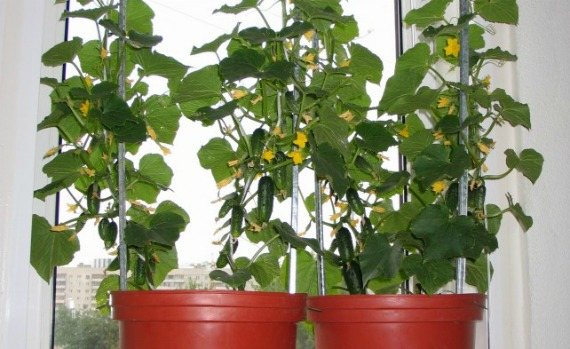

Not all varieties of cucumbers are suitable for home cultivation. It is best to choose first generation parthenocarpic hybrids. These plants do not need additional pollination and form only female flowers on the bushes.
The variety must meet the following requirements:
- be early or mid-maturing;
- have increased productivity indicators;
- form short fruits (up to 25 cm);
- differ in shade tolerance and resistance to temperature extremes.
Some people try to plant bee-pollinated varieties, but in this case additional efforts will be required to obtain a crop.
The following varieties of cucumbers are popular among lovers of home vegetable growing:
- April F1. Parthenocarpic hybrid with early maturation. The variety is resistant to bad weather and disease, pleases with amicable fruiting, easy to care for. The first cucumbers appear 1.5 months after the seeds sprout. Fruit size - 15-25 cm. The skin is tuberous, with slight pubescence.
- Benefit F1. A mid-early hybrid, a little more than 1.5 months pass from germination to fruiting. Does not require pollination. The yield is high. The plant gives many side shoots, it needs to be formed. The size of the fruits is 10-13 cm. The skin is small tuberous, bright green. The pulp of zelentz is juicy, sweet, does not contain bitterness. Benefis is resistant to disease. Requires a rare landing, as he loves space.
- Zozulya F1. An early ripening hybrid. The bush does not need to be shaped. Fruiting 42-48 per day from the moment of germination. It is characterized by a high yield rate. Fruit length - up to 24 cm. There are pimples and thorns on the soft thin skin. The greens are sweet to taste, with a pleasant aroma. The pulp contains few seeds.
- Goosebump F1. Hybrid with early fruiting dates. It will be possible to harvest the crop after 35-40 days from the moment of germination. The size of the fruits is 11-13 cm. The plant is resistant to diseases, at home it can bear fruit all year round. Harvest amicable, abundant. The thin skin of the fruit is covered with medium-sized tubercles.
- Sail F1. Hybrid plant producing high quality fruit. Has a female flowering type. Zelentsy tuberous, with sparse pubescence. Cucumbers of this variety enter fruiting on 46-50 days from the moment all the seeds sprout. Differs in a friendly return of the harvest. The fruits have a universal purpose.
- Regina. A mid-season high-yielding variety of the parthenocarpic type. Disease resistant. The size of the zelents is 10-12 cm. The fruits have a lumpy surface. The pulp is tasty, without bitterness.
- Crunch F1. A high-yielding hybrid with a long fruiting period. Fruits are 8-10 cm in size. The flesh is unusually juicy, crispy, without bitter aftertaste. The plant is characterized by high disease resistance.
On a note! Late-ripening cucumber hybrids are not suitable for growing at home.
The best varieties for growing at home
Before planting cucumbers on the windowsill, it is recommended to study the characteristics of the cucumber varieties. The breeders have specially selected varieties with the possibility of indoor breeding. Most of them are hybrids. The peculiarity of these species is the ability to form fruits regardless of the environment. Given the limited space in which they will grow, they were created with the possibility of self-pollination. In scientific terminology, hybrid cucumber species were called parthenocarpic.
To plant cucumbers in winter, they most often use the following varieties bred for cultivation in an apartment:
- Balcony. The hybrid was first bred in 2007. Perfectly adapted for indoor cultivation. Planted in indoor and outdoor ground. Undemanding to the area of habitation, a variety with early ripening, the average period is 39–41 days from the first shoots. High productivity. The length of the lashes is small, the branching is common. The variety is self-pollinated.
- Buyan. This hydride requires an abundant supply of light, is demanding on the temperature regime. It is distinguished by its duration of fruiting, the compact size of the branches. It has an average of 5 ovaries per knot. The better the conditions of detention, the more fruits will be obtained from the bush.
- Ant. Differs in early maturity. Bred for sowing in open ground. Suitable for canning.With the correct technology of care, the amount of the crop will be 10–12 kg. He will not need help in pollination.
- Marathon. This is a variety of hybrids that needs third-party pollination. Thanks to this process, it has a high fruiting rate of more than 25 kg per square meter. The harvest begins to appear on the 85th day from the first shoots. Popular among gardeners due to its disease resistance.
- Olympiad. Marketable yield in a winter greenhouse is 23.2 and 32.8 kg / sq. m. Resistant to the cucumber mosaic microbe. Advantages of the hybrid: the highest yield and marketability of products, good taste of zelents.
Sowing dates for cucumber seeds
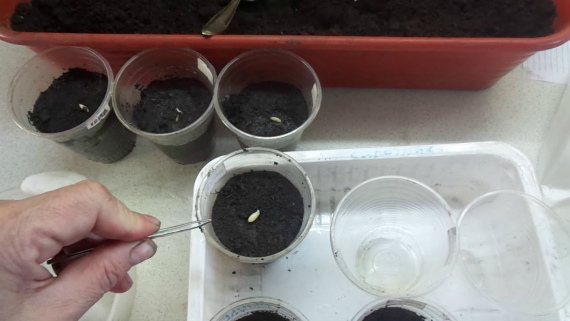

In principle, cucumbers can be grown at home all year round. If you want to get a crop by a specific date, you need to take into account the growing season of the variety. This information can be read on the seed package.
- To get fresh cucumbers for the New Year, they will need to be sown at the end of October.
- Sowing in January will yield in March.
- It will be possible to grow cucumbers for the May holidays by planting in mid-February.
Of course, in order to get the harvest on time, it will be necessary to ensure the correct light and temperature conditions, and regular watering of the plants.
Growing cucumber seedlings at home
When to sow cucumbers for seedlings in 2020 according to the lunar calendar
Timing recommendations
The advantage of growing cucumbers at home is that you don't have to be tied to a deadline. You just need to take into account the period from the date when the seeds sprout to the moment the fruits ripen. If there is a desire to harvest for the New Year, then seeds are sown in October.
Of course, it is easier to grow vegetables during the warmer months. Therefore, in early spring they are engaged in sowing in order to harvest their own crops at the beginning of summer. For fresh vegetables to delight longer, you can plant seeds in the summer (at the end of August), then the cucumbers will appear on the table in October.
Preparatory work before sowing
After the variety is selected and the seeds are purchased, you will need to prepare everything you need for sowing. Together with the seed in the garden center, you can buy land at the same time. If there are no suitable containers at home, they will also need to be purchased.
The choice of soil mixture
For planting cucumbers, a universal soil or substrate for growing pumpkin crops is quite suitable. Land bought in a store undergoes all the necessary preparation at the production site and is completely ready for planting.
You can compose the soil yourself according to the following recipes:
- Mix equal amounts of peat and humus. Add a glass of wood ash to 1 bucket of soil.
- Take 1 part of garden soil, turf and compost. Add a little river sand, rotted sawdust, ash to the mixture.
Self-prepared soil needs to be disinfected. For this purpose, you can use roasting in the oven, treatment with boiling water and a solution of potassium permanganate, freezing.
The listed procedures rid the soil of pathogenic microflora and pest larvae. Processing is carried out several days before planting. It takes some time for the beneficial soil bacteria to recover.
The choice of container for seedlings
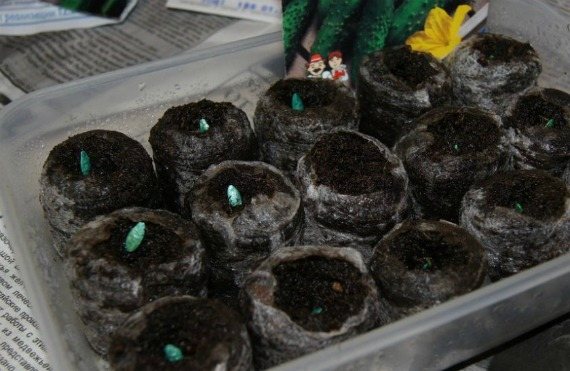

Initially, seedlings are to be grown, which are later dived in a container of a suitable size.
For seedlings, wooden boxes, plastic containers, large peat tablets or cups with a volume of 200-300 ml are used. Before using a container or box, they are washed with a brush and laundry soap, scalded with boiling water.
Peat tablets are placed in a common container and filled with warm water to swell. As soon as they increase in size several times, it will be possible to land.
Growing cucumbers in a package on the window - video
Top dressing
In the process of building shoots and fruits, the plant consumes microelements from the soil. Their stock is replenished by applying fertilizers, otherwise all kinds of violations arise. For example, with proper supplementary lighting, the cucumber grows intensively and purple streaks suddenly appear on its leaves, and the underside acquires a purple hue completely. This is a sign of a lack of phosphorus, additional feeding is required.
What to feed?
There are two types of fertilizers:
... This is compost and humus from horse, cow manure, bird droppings. It is also used fresh, but then an infusion is made from it and then diluted at the rate of 0.5 liters of fertilizer per 10 liters of water. Similarly, mullein is used - fermented liquefied manure (bubbles appear on the surface). It is impossible to use fresh droppings and manure in pure form due to the large number of pathogenic microorganisms contained in them. Ash also belongs to organic fertilizers, but it is applied extremely sparingly, otherwise the soil will become alkaline. You just need to "salt" the soil with ashes. In urban conditions, a fermented infusion of banana peel, diluted with a 10-fold amount of water, is used;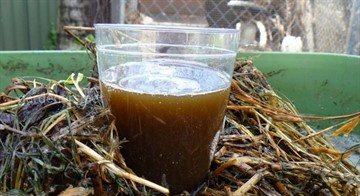

organic- chemical... These are various complexes of nitrogen, phosphorus and potassium compounds, for example, nitrophos, nitroammophos, etc.
There are options with a predominance of one or another element. So, a mixture with an increased proportion of nitrogen is applied in the spring, when the plant is intensively gaining green mass. Potash - at the beginning of fruiting and before wintering.
Frequency
Chemical fertilizers are applied to a limited extent, otherwise the soil is saturated with undesirable substances. Chlorine is especially detrimental to cucumbers, therefore nitroammophos is introduced in the smallest amount. Then it is better to use complexes with potassium in sulfate form.
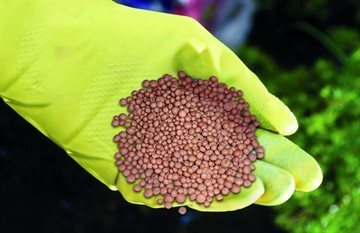

Chemical feeding is done twice during the growth of shoots and twice during the formation of ovaries. The dosage is indicated on the package.
It is better to apply fertilizers in the form of a solution when watering, reasons:
- so they are better absorbed;
- a burn of roots due to direct contact with crystals is excluded.
Humus and compost are added without restrictions. The culture grows even on pure humus, while it develops rapidly and gives a lot of fruits.
Sowing cucumber seeds
When preparing for sowing, try to guess so that the planting date falls on favorable days according to the lunar calendar.
The seeds are preliminarily etched in a solution of potassium permanganate, then washed and wrapped in a damp cloth for swelling. These seeds will germinate faster.
Planting is carried out in rows with an interval of 2-3 cm to a depth of 1 cm.If sowing is carried out in individual containers, for safety reasons, 2 seeds are immediately embedded in the hole. The weaker seedling is later removed.
After sowing, the soil is moistened with a spray bottle and covered with foil to create greenhouse conditions. Now the seedlings need to be put in the brightest place and kept at room temperature until shoots appear.
What capacity is right
For growing seedlings, use special containers or self-prepared containers.
Seedling pots
Separate cups of different sizes are the best choice for germinating seeds. Small products are used for sowing. Larger ones are needed for a dive. The advantages of store containers are low price, multiple use, and the root system of plants is minimally injured. Disadvantages of homemade containers - you need to make drainage holes, large boxes are required to carry.
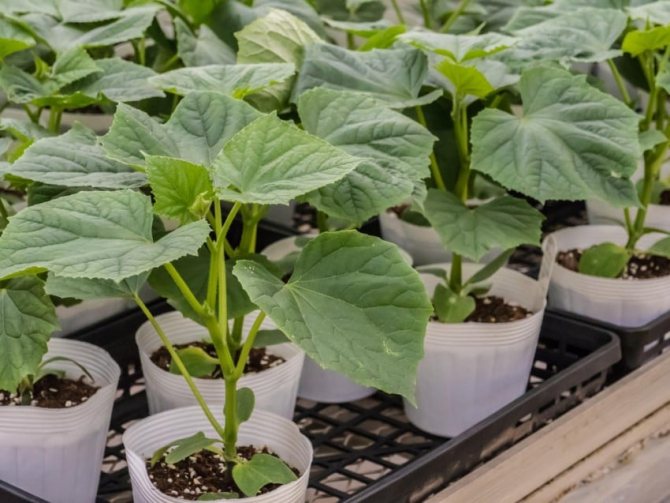

Planting trays
Manufacturers produce containers of different sizes, so it is not difficult to choose a product according to the size of the window sill. You need to pick up boxes 8-10 cm high. The advantages of the container - it is easier to take care of the seedlings and it is easy to carry them. The main disadvantage is minor damage to the root system of the seedlings during transplantation.
Transplanting cucumbers to a permanent place
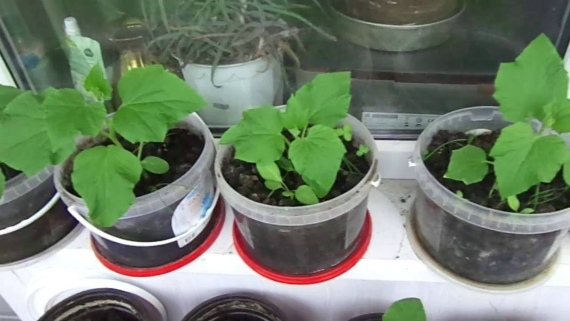

The optimal age of seedlings for picking is when it forms 2-3 true leaves and a compact, unstretched stem.
A feature of varieties for home cultivation is the presence of small leaves and a strong main shoot, so the plants will not fall even at the stage of appearance of 6-8 leaves.
Such bushes can be transplanted to a permanent place without worrying that they will not take root well.
Any container is suitable for growing vegetables at home.
- This can be a clay or plastic pot, a bucket, or a wooden tub. The main thing is that the volume of the container is at least 5 liters, because cucumbers have a powerful root system.
- Some have adapted to use 5-liter plastic bottles with a cut-off neck for this purpose. A drainage hole must be made in the bottom to drain excess water after watering.
Drainage is certainly laid as the bottom layer. The soil should be taken the same as for seedlings. The container is filled with earth not to the edge, but below this level by 4-5 cm.
In the future, when, during the growth of cucumbers, the roots begin to bare, it will be possible to fill up the soil without any problems. The substrate for planting seedlings must also be disinfected.
Pickling cucumber seedlings in separate containers
You can start transplanting seedlings when three leaves appear. Flowerpots (from 25 cm in diameter) or balcony boxes (about 20 cm high) are ideal. Only one plant is planted in pots, and 2-3 can be placed in boxes, trying to maintain a distance of 25-30 cm between them, so that they can develop well.
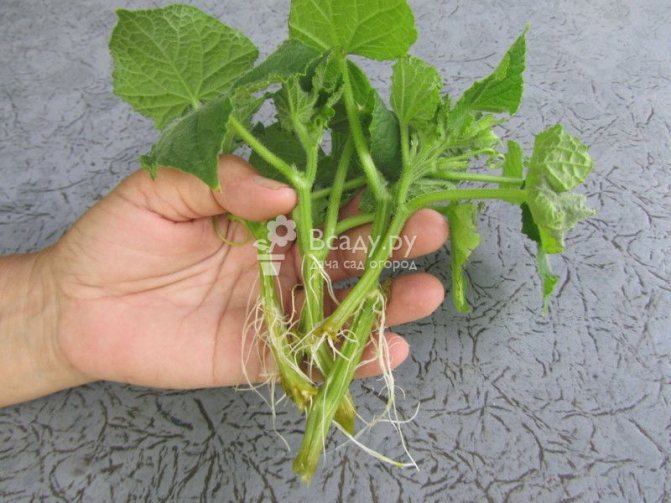

Pickling cucumber seedlings
You should start picking cucumbers as carefully as possible, trying not to injure the root system. In order for the seedlings to successfully take root, the pots and boxes must be removed from the illuminated window sills for 2-3 days or the windows on the balcony must be shaded (use cardboard shields, close blinds or trellises).
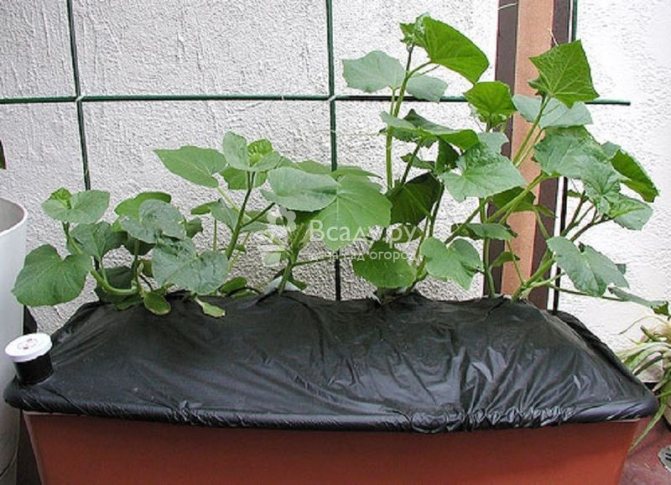

Growing cucumbers on the balcony under the film
In order for moisture to be better preserved, and the roots of plants to freeze less from drafts, you can cover adult plants with foil, at an air temperature of 15-20 degrees.
Features of caring for cucumbers on the windowsill
For your cucumbers to bear fruit, they need the right move, taking into account all the needs of the culture. Pay attention to the following points.
Watering
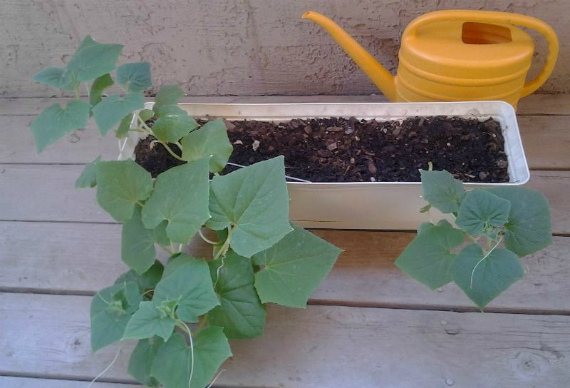

Cucumbers are very fond of moisture, but at the same time they do not tolerate stagnation of water in a pot, a sufficient amount of oxygen must flow to the roots. Water them regularly to keep the soil from drying out.
For large bushes in dry air conditions, daily watering is necessary; in high humidity, this can be done 2-3 times a week.
When the plants grow strong roots, they can drink the water poured into the pan. Sometimes you can use this method of watering. To increase air humidity, install a humidifier in the room, or place containers with expanded clay on the windowsill, into which you will regularly add water. In the evenings, cucumber leaves can be sprayed with a spray bottle.
On a note! Water for irrigation must be settled and at room temperature.
Fertilization and dressing
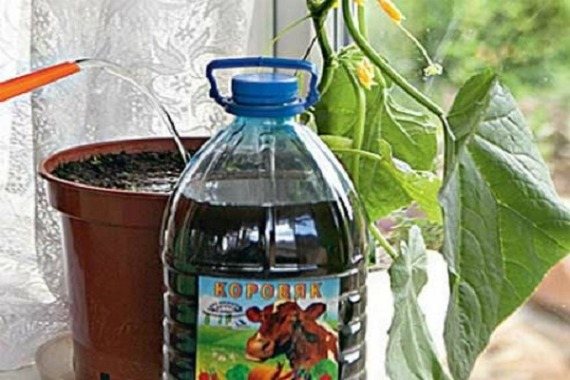

So that the harvest is not meager, the cucumbers must be regularly fed with fertilizers. Top dressing is especially important during the fruiting period.
Adult plants are fed every 7-10 days with industrial mineral fertilizers.
- A mixture of mullein infusion (at a concentration of 1:10), superphosphate (20 g) and potassium sulfate (15 g) is well suited.
Cucumbers also like feeding with folk remedies: infusion of tea, wood ash, yeast, eggshells, iodine.
The first feeding is applied to the plants at the age of 2 weeks. The composition is prepared from the following components:
- 10 liters of water;
- 15 g potassium;
- 5 g of ammonium nitrate;
- 5 g magnesium;
- 3 g superphosphate.
Fertilizers are thoroughly dissolved in water and irrigated at the root, trying not to get on the leaves of the seedlings.
Pinching and shaping a bush
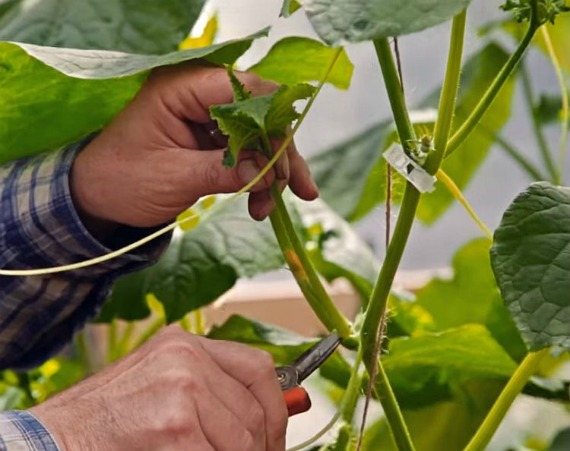

By the type of growth, cucumbers are lianas, their whips at home can grow up to 2 m in length.In each container, you will need to fix a vertical rigid support along which the growing shoots will curl.
Most home-grown hybrids do not grow too tall, but they branch a lot.
It is recommended to pinch vigorous varieties after the appearance of 10-12 leaves. A cucumber plant is formed into 1 or 2 stems, breaking off all the tendrils that appear.
Some pinch the main shoot when the height of the window no longer allows the vine to grow up. Lateral shoots are removed, leaving 1-2 leaves.
On a note! If the bush is not formed, it will build up an excessive amount of leaf mass to the detriment of fruiting and, moreover, will take up a lot of space.
Tying
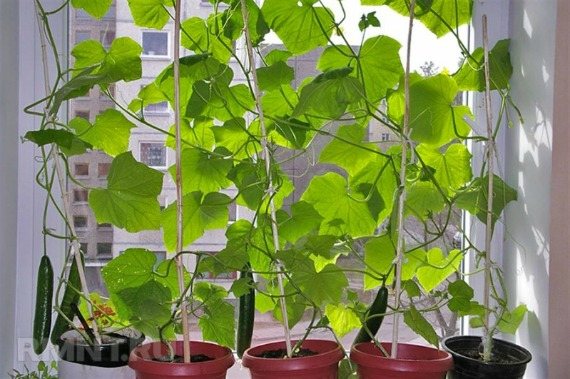

Without tying, the bushes are poorly ventilated and shade each other. The lashes are tied with a nylon cord or twine to a vertical support located in a pot.
You can build a trellis by screwing a metal ring to the window slope, to which the cord is tied, the second end of the twine is fixed on a wooden peg stuck into the pot. As the lashes grow, they are tied up, or attached to the cord with special plastic clips.
On a note! Some growers fix a plastic mesh in the window opening. Mustache varieties will be able to cling to the cells themselves, whiskerless varieties will need to be tied up.
Pollination
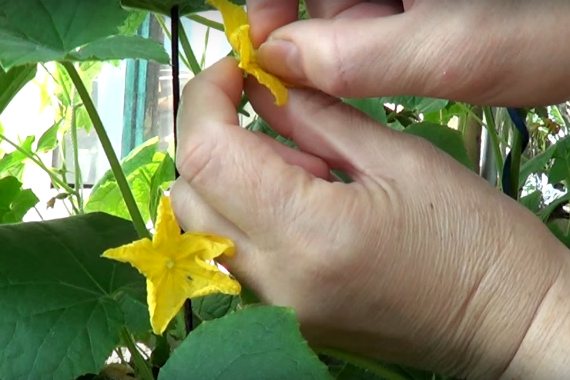

Parthenocarpic cucumbers do not need artificial pollination. If you have planted a bee-pollinated variety, you will have to take part in the transfer of pollen from male flowers to female specimens. It is necessary to carry out the procedure during the entire flowering period. For this purpose, you can use a soft paint brush or cotton swab.
Male flowers form at the base of the stem. Most often they form an inflorescence of 5-7 buds. It is their experts who call them barren flowers. Female flowers grow singly, at the place of their attachment to the peduncle, you can see a small tubercle, from which the fruit is subsequently formed.
When transferring pollen, you should make sure that it has settled on the brush. In this case, a yellow coating will be visible on the villi. It is better to transfer pollen from 2-3 male flowers to one female flower. This increases the chances of successful pollination.
On a note! It is best to pollinate the flower on the second day after it has opened.
Tying and shaping cucumber bushes
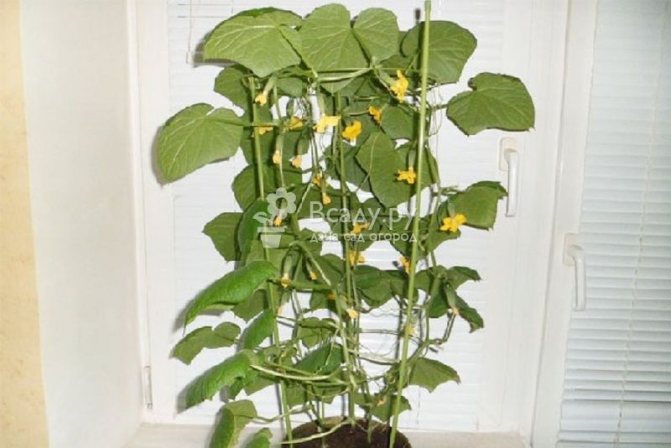

Garter cucumbers on the windowsill to the trellis
Side shoots regularly appear on the central lashes of the grown bushes, they need to be pinned at the base. It is important to ensure that no more than two shoots are formed on one plant. Formation begins when 8-9 leaves appear in plants.
To achieve a good harvest of cucumbers grown indoors, they must be tied up. It is convenient to use as a comfortable support:
- Garden or construction mesh with large cells, reinforced with supports in the ground;
- Strong ropes 1.5-2 m long, which the shoots can twine and hold tightly. They are pulled over the frames of window panes or tied directly to the ceiling of the loggia, setting the desired direction.


Garter cucumbers on the balcony with ropes
6-7 days after transplanting, an additional twine is tied over each bush at a height of 10-15 cm from the ground. At the same time, the lower edge is reinforced with a loop between the second and third leaves of each bush so that the bushes grow vertically in the right direction.
With the appearance of ovaries, you need to ensure that the cucumbers do not outgrow. Timely harvest will allow new fruits to form well and grow faster.
Harvesting rules
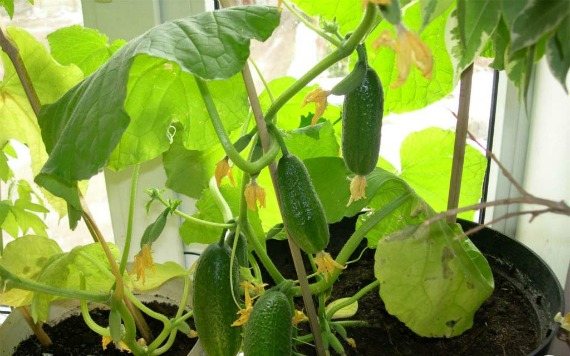

After 35-40 days from the moment the shoots appeared, it will be possible to enjoy the first cucumbers collected with your own hands. While the bush is growing, you are harvesting the fruit that has formed in the axils of the main stem.
If the bush is not formed, after the top of the head rests against the slope of the window and pinches it, second-order shoots will begin to develop on the plant.
Now cucumbers can be harvested from these lashes. The main thing is to do this as soon as the next greenback ripens. The faster you remove ripe fruits from the bush, the more willingly new ovaries will begin to develop and the yield will be higher.
Read more in the article: How to grow tomatoes on the balcony at home
Photo gallery
The photo shows the stages of growth of cucumbers on the windowsill - from germination to harvest.
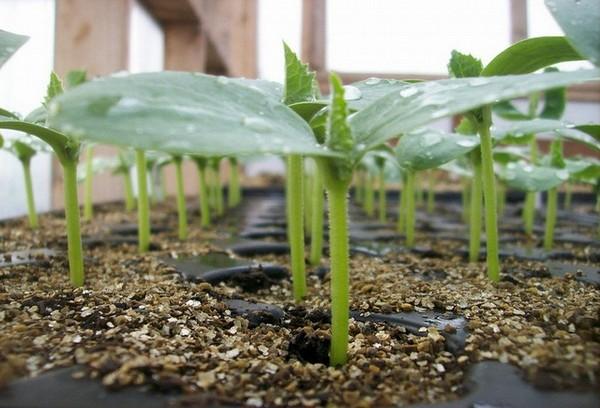

First shoots
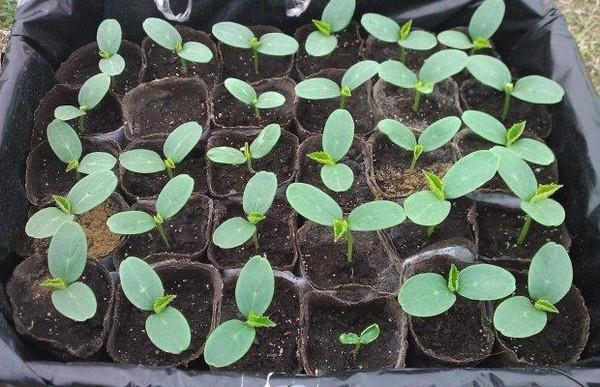

Seedling
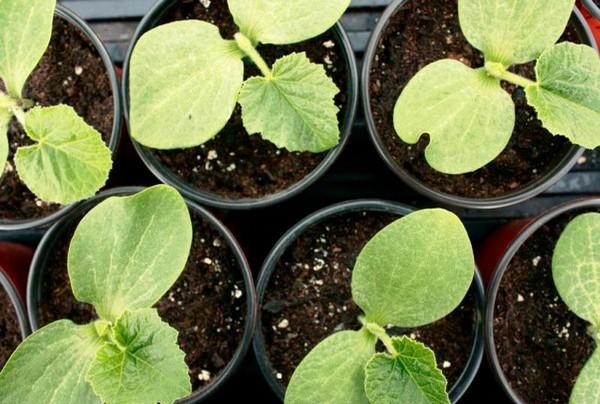

Cucumber with the third leaf
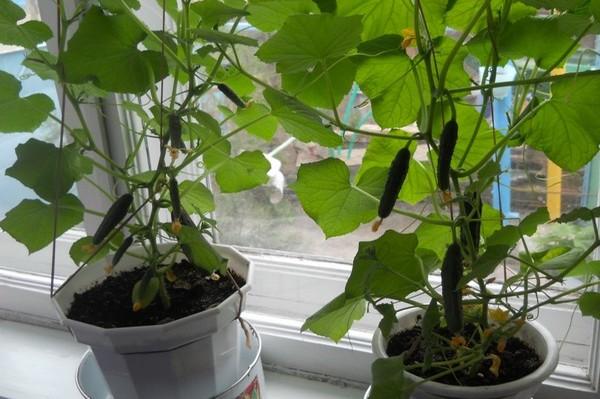

Formed bush
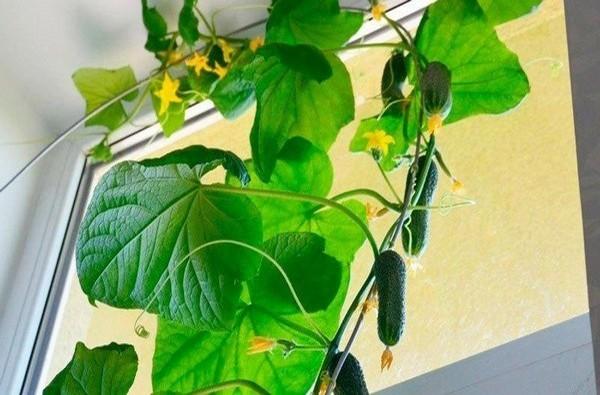

Lightweight garter option
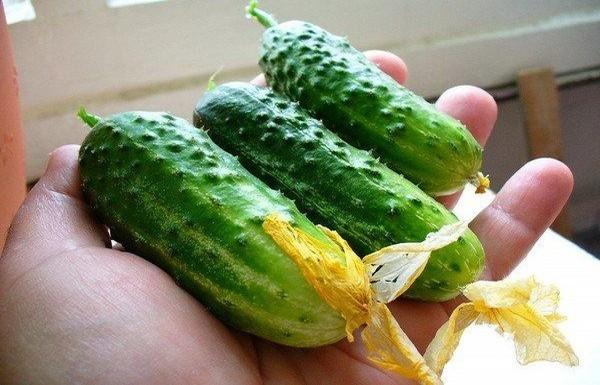

Harvesting
Possible problems when growing cucumbers on a windowsill
For inexperienced vegetable growers, the process of growing cucumbers in an apartment does not always go smoothly. Either the leaves will suddenly turn yellow, or the ovaries will fall off, or for some reason there is no flowering. And in the early stages, you can run into problems.
Most often, the reason is not quite suitable conditions and errors in care:
- When growing seedlings in winter, there is often not enough light, and the stems are stretched, and the foliage turns yellow. Light up the plants additionally from 8 am to 4 pm. Starting in March, the backlight can be turned on for only 4 hours a day. In low light, plants can also give up fruiting.
- If the ovaries form, but do not grow, it may be due to a lack of iodine. Prepare a top dressing with 1.5 liters of water and 5 drops of iodine tincture and water the plant around the edge of the pot. Top dressing near the stem can cause root burns. The second reason for the falling off of the ovaries may be a lack of moisture.
- Sometimes, when grown in an apartment, cucumbers are attacked by whiteflies and spider mites. At the first sign of pests, spray the plants with a solution of laundry soap. Repeat processing if necessary. Chemicals should not be used in the house - it is dangerous to health.
- So that the bush does not grow ugly and crooked, it must be turned 180 degrees daily, then the plant will receive light evenly.
- If the leaves turn yellow and partially die off, then the cucumbers are lacking in nutrients. The reason may be in the insufficient volume of soil, its poor quality, irregular feeding. Try to correct the situation by urgently applying mineral fertilizers.
Seed and soil preparation
Before planting, the seeds are disinfected and germinated.
For disinfection, the inoculum is soaked for 24 hours in Bordeaux liquid or potassium permanganate. Disinfection destroys pathogenic microflora, protects against diseases and pests. The seeds are disinfected by ordinary heating, keeping in the oven for 2 hours at a temperature of +180 ° C.
The next stage of preparation is germination. It increases seed germination and strengthens the immunity of future plants. The cheapest and easiest way to germinate is to soak in water. Warm water is poured into a deep container and disinfected seeds are poured onto the bottom. Withstand 12 hours, while the liquid is changed every 4 hours and the inoculum is gently mixed. Then the seeds are taken out of the water, wrapped in a gauze bag and placed in a warm place for 3 days.
For planting seeds, use a ready-made mixture from a store, for example, "Universal" or "Krepysh" soil. Such land has already been disinfected and equipped with all the necessary nutrients.
On indoor cucumbers, leaves turn yellow and dry
This is another problem when growing cucumbers at home.Why do the leaves on cucumbers turn yellow and what to do?
- Improper or irregular watering the soil is too damp or, conversely, dry. Watering is necessary once a week with water at room temperature. If the air at home is too dry, spray the plant in the morning or in cloudy weather;
- Lack of nutrients and minerals. Of the deficiency, it affects the insufficient production of chlorophyll, due to which the leaves have a rich green color. Feed the plants with fertilizers that contain nitrogen, magnesium, iron and the problem will disappear;
- Inspect the leaves and stem regularly for pests. They can easily be brought in from the ground, so use good quality soil to plant cucumbers. And if pests have appeared, then treat with infusions of garlic or tobacco. Can be treated with ready-made insecticides, but if there are no small children at home;
- Root rot is a fungal disease in which the root system begins to rot. To prevent disease, regulate watering, do not fill the soil with cold water, do not place containers with plants on a cold windowsill. If the leaves start to turn yellow, transplant the plant into another container. When replanting, deepen the plant more into the soil, or huddle the stem 5 cm higher to form other, healthy roots.
The quality development of plants directly depends on the starting points. Pay attention to soil selection, seed preparation and proper planting.
Land preparation
Those who have a summer cottage often use the land from the garden plot, mixing it with humus or rotted manure. Others add more needles, wood ash, bird droppings, sawdust, sand, etc.
It is better for novice gardeners to use vermicompost in combination with coconut fiber in a 1: 2 ratio. This substrate can be purchased at a flower shop. Or purchase a ready-made soil mixture specifically for cucumbers.
Selection of capacity
You can use any available means - plastic buckets, bottles, flower pots. The main thing is that they have drain holes for water. Drainage is laid on the bottom - expanded clay, broken brick (red), river pebbles, etc. Its layer should be 5 cm. Then the prepared soil is poured into the container and watered. The vegetable patch is ready.
Seed preparation
Only the seeds of the hybrids, which have a special colored coating (usually red or green), do not require preliminary preparation. This planting material has already passed all the necessary processing. The rest will have to do the following manipulations:
- disinfection - the seeds are soaked for 20 minutes in a solution of potassium permanganate (0.5 g per glass of water);
- to increase fertility, they are kept for 2 hours in a boric solution (1 g of acid per glass of water);
- to increase immunity, a solution of wood ash is used (1 tbsp per glass of water); seeds are kept in it for 3 hours.
Then the seed is laid out on cotton pads so that excess water is absorbed into them.
Which cucumbers are better
To begin with, it is worth choosing the best varieties that can be successfully grown on the windowsill. If your balcony is insulated, any varieties of this plant grow just perfect and give an excellent harvest.
Mostly they prefer to use varieties of hybrid origin. The fruits will be tied without special pollination, so it is these varieties that are best planted at home.
Varieties that should be planted on your windowsill:
- Shchedryk - ripens quickly and approximately 45 days pass before the harvest. Cucumbers grow in a whole bunch of 5-7 pieces. The vegetables are small and ideal for salads.
- Khutorok - ripens very quickly, namely within 30 days. Cucumbers are about 10 cm long and have black thorns. At home, you can easily pollinate these plants. You can transfer pollen from the male to the female inflorescence with a brush.
- Crisp is an ordinary cucumber that is capable of producing a crop within 50 days after germination.The hybrid can be pollinated on its own and produces a large amount of yield. If you organize the right care, then you can collect more than 40 fruits from this variety. The vine grows actively and abundantly.
These varieties can also easily be grown in a greenhouse or open field. You can pick up other varieties of cucumbers - it all depends on individual preferences.
Cucumbers Shchedryk - high-yielding early variety
Recommendations for successful cultivation
To get large yields of cucumbers at home on the windowsill in winter, avoiding mistakes, you must adhere to certain rules:
- The soil for sowing must be thermally treated and allow moisture and air to pass through well - it is better that it is a mixture of peat and river sand.
- Planting material needs to be bought only for winter crops - it must be disinfected and germinated for quick germination, there is no need to prepare seeds in a shell.
- Freshly harvested seeds are not suitable for sowing.
- It is better to plant seedlings in separate containers for several pieces, then leave a strong sprout, and remove the rest.
- The soil should always be not waterlogged, but moist.
- The best temperature for germination is + 22 ° C, the increased humidity of the room is achieved by spraying the plantings several times a day. After the emergence of seedlings, the temperature and humidity are slightly lowered (up to +20 ° C), but the amount of light is increased with the help of backlights with fluorescent lamps.
- Water for irrigation should be warm and settled.
- When the first true leaf appears, you can start feeding.
- For winter fruiting, plants must be protected from a cold windowsill by placing the container on a stand. A support for whips will save from contact with the window.
- When the plant is in bloom, the mesh with the fixed cucumber branches must be shaken repeatedly to speed up pollination.
- Collecting fruits every day will extend the life of the bush.
